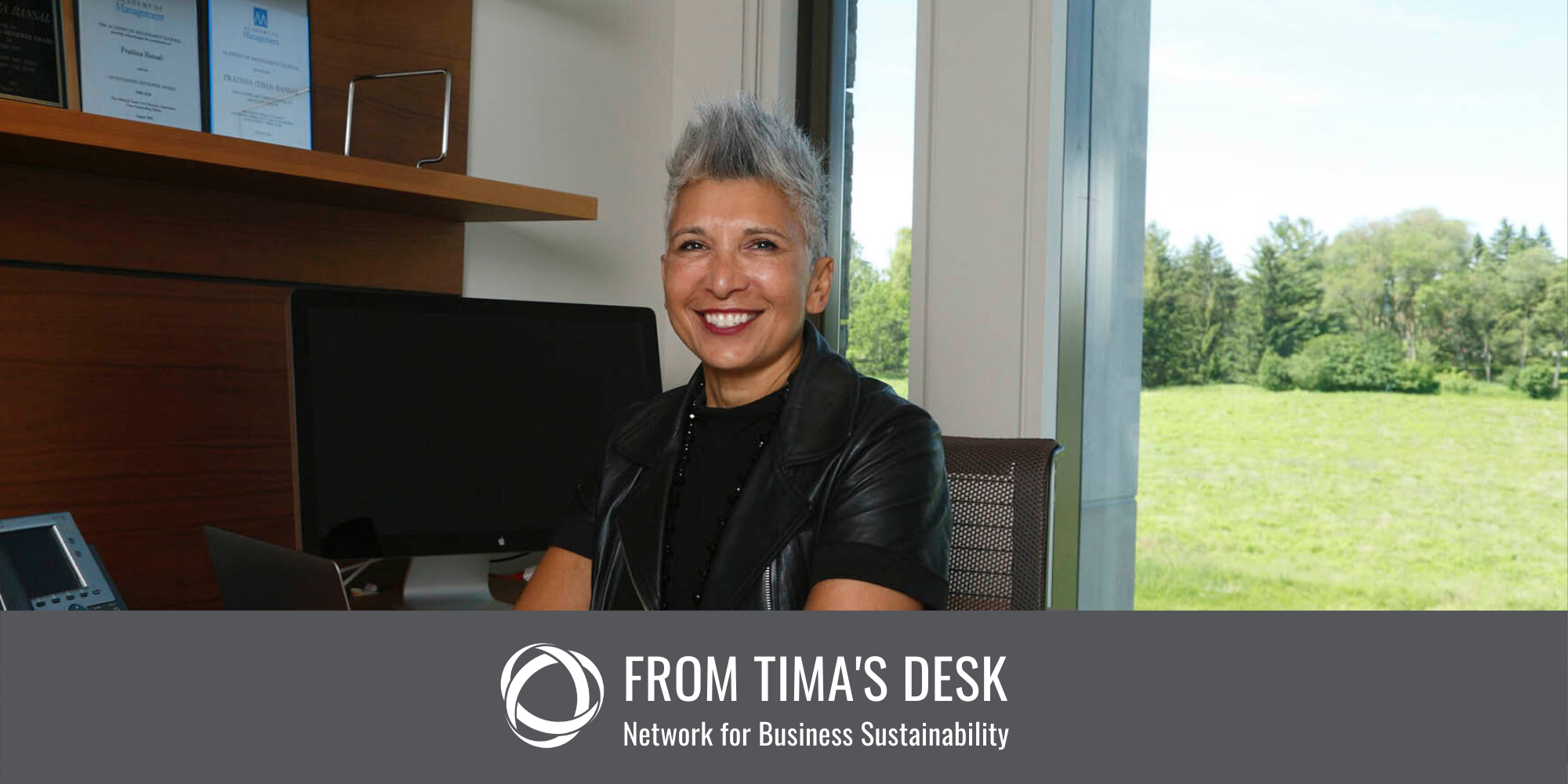A stakeholder perspective often forces companies to choose favourites. A systems perspective is better for everyone.
Dr. Tima Bansal is Founder of the Network for Business Sustainability.
I have always been uncomfortable with a stakeholder perspective in strategic decision making. It was only when the United States Business Roundtable made its recent announcement that I understood why.
On August 19, 2019, the Business Roundtable signed a Statement on the Purpose of a Corporation, which advocated a stakeholder perspective over a shareholder perspective for businesses.
The signatories stated that “we share a fundamental commitment to all of our stakeholders” (underlining in original). The Business Roundtable includes 192 CEOs of America’s largest corporations, including Amazon, Apple, Exxon, and Walmart.
Most executives and business school professors are familiar with the ‘stakeholder perspective’. Its principles are simple: all organizational stakeholders, not just shareholders, should matter to the organization. The key stakeholders are customers, suppliers, and the community, but there may be numerous others who have a stake in the company’s actions.
The stakeholder perspective is often used in describing corporate social responsibility (CSR), the social license to operate, shared value, and corporate citizenship.
As I learn more about systems thinking, I see a better alternative to the stakeholder perspective. A systems perspective is not only at the heart of sustainability, but doesn’t force managers to choose favorite stakeholders.
In this article, I describe the stakeholder perspective and its shortcomings, and how a systems perspective can find new solutions.
Illustrating a Stakeholder Lens through Walmart’s Decision on Guns
Walmart CEO Doug McMillon is embracing a stakeholder perspective with some recent decisions. Most visibly, on September 3, 2019, Walmart committed to stop selling ammunition for handguns and assault-style weapons. This action came in response to the August 2019 shooting in a Texas Walmart that killed 22 people.
Walmart estimated that its market share of ammunition would drop from 20% to about 6%. Dan Bartlett, Walmart Executive Vice-President of Corporate Affairs, said, “We feel like we are striking a responsible balance between the interests of law-abiding citizens who are exercising their legal rights and the safety concerns of our associates and customers.”
Walmart chose one set of stakeholders over another. In this case, citizens, employees and Walmart’s general customers won over its shareholders and gun-toting customers. In other decisions, such as its continued use of single-use plastic bags for customers, Walmart chooses its customers over citizens.
The Shortcomings of the Stakeholder Perspective
Looking at Walmart’s actions, I see the limitations of the stakeholder perspective. Companies are asked to take the moral high ground, but there is little guidance over which morals should prevail.
Walmart responded to the issue of guns when they experienced gun violence at a Walmart store in El Paso. Similarly, they responded in 2005 to climate change issues when they experienced the devastation of Hurricane Katrina in their operating territory.
Yet, they have not responded to issues that are less dramatic but devastating for society in the long run, such as low wages paid to employees. Walmart chooses the issues in which it exercises a stakeholder perspective, and it chooses a shareholder perspective for the rest.
This approach is not limited to Walmart. Many corporations simply choose their favorite issue and favorite stakeholders, which lets them blow with the winds of change. A stakeholder perspective lacks a compass.
In a way, I understand the lack of consistency. Navigating with a stakeholder lens isn’t easy. A stakeholder perspective considers the interests of all affected parties in its decisions. By widening the set of actors, companies add complexity to decisions. When stakeholder interests compete, the decision options open to executives narrow and often reduce the profits to shareholders. Let me explain.
Executives have three ways to deal with competing stakeholders: 1) search for win-win solutions, but this narrows the number of decision options; 2) choose a win-lose solution (i.e. trade off one stakeholder’s interests over another’s), meaning that at least one stakeholder group is ignored; 3) seek compromises, so that each stakeholder group gives up something.
Each of these approaches requires negotiation and complexity — often resulting in lower profits, at least in the short run. When companies optimize the needs of only shareholders, life is simpler and they can optimize short-term profits.
This is why so many corporations claim to take a stakeholder perspective, but often continue with the status quo until the issue is salient.
It reminds me of the SWOT model from decades ago. Analysts simply identified the organization’s strengths, weaknesses, opportunities and threats, but there was no guidance on what to do with the list. SWOT provided a map, but no guidance on the destination.
Companies find a stakeholder perspective easy, when there are obvious win-wins. They are more than willing to turn off lights and save water. However, such wins will only take us so far. Sustainability often requires hard trade-offs among stakeholders.
What’s the solution? A systems perspective!
A systems perspective asks companies to consider the broader system in decision making, not just stakeholder groups. It asks executives to shift their gaze from the parts (the stakeholders) to the whole (society).
When executives see society in its entirety, new options come into view. Executives either see new win-wins or they see the necessary trade-offs to benefit the entire system. This might mean that no single stakeholder is happy, but that all stakeholders will gain in the long run.
If you have children, you likely practice this type of thinking intuitively. Let’s say two of your children are warring over your only tablet. What do you do?
You automatically think about what is best for the family — you included — in the long run. You realize that by giving the tablet to one kid, the other kid will give you grief for a long time. So, you do the opposite. You decide just to remove the tablet altogether, so neither kid is happy. But, the next time the kids want your laptop, they will figure out a way to get along.
This is neither a win-win or a win-lose, but a lose-lose with long-term benefits. This is a systems perspective, not a stakeholder perspective.
Changing the focus to the systems level is something I wrote about with my colleagues, Anna Kim and Michael Wood. We illustrated the different insights from looking at the parts versus the whole through the example of predators and prey. When looking at the parts, i.e. predators and prey, there is a negative relationship between the number of predators and prey. More predators mean fewer prey and vice versa. But, when one zooms out to look at the whole landscape, one can see that there may be a positive relationship between predators and prey. If the resources increase in general, then there may be more predators and more prey. Or, if there is a drought, then there may be fewer of each.
Extending this analogy, I am asking executives to zoom out so they can see the underlying relationships that will allow everyone to flourish.
Even if a systems perspective seems new to you, it may be easier to execute than a stakeholder perspective. Rather than dealing with conflicting interests, companies ask stakeholders to design a system that flourishes over the long run. Then, ask them to work backwards to today and determine what decisions need to be made.
A systems perspective gives executives guidance on how to choose among stakeholders and how to change the system to benefit all stakeholders.
Walmart: Stakeholders and Systems
With the issue of guns, I could argue that Walmart has actually taken a systems perspective. Walmart has chosen not just to remove the most lethal of guns (and ammunition) from its shelves, it is also lobbying Congress for common-sense gun laws. The presence of easily available handguns will reduce community resilience over the long run. Additionally, Doug McMillon is stepping up to chair the United States Business Roundtable in January 2020, which will give him even more influence in shaping the opinions of its 192 corporate CEOs.
A systems perspective looks beyond local stakeholder conflicts, because it focuses not just stakeholders’ views, but on the big picture over the long run. It asks companies not just to resolve stakeholder conflicts in the short run, but to do the hard work of figuring out what is best in the long run, even if it means that we all have to give something up in the short run.
Continuing the Conversation
As always, I welcome your reactions. Please feel free to message me (@TimaBansal, tbansal@ivey.ca) or the NBS community (@NBSnet) privately or publicly.
From Tima’s Desk
Dr. Tima Bansal, NBS’s Founder, regularly shares her observations about business sustainability. Click the button below to see the full series.




Add a Comment
This site uses User Verification plugin to reduce spam. See how your comment data is processed.This site uses User Verification plugin to reduce spam. See how your comment data is processed.